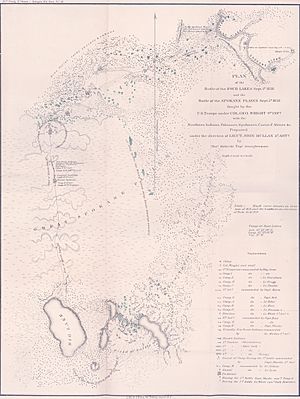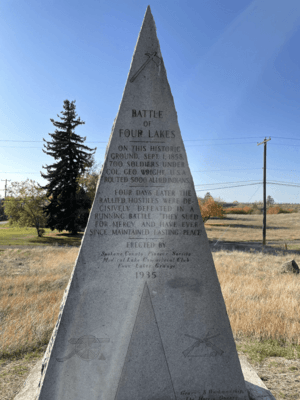Battle of Four Lakes facts for kids
Quick facts for kids Battle of Four Lakes |
|||||||
|---|---|---|---|---|---|---|---|
| Part of the Coeur d'Alene War, Yakima War | |||||||
 Map showing the Battle of Four Lakes and the Battle of Spokane Plains |
|||||||
|
|||||||
| Belligerents | |||||||
| Yakama Palus Spokan Schitsu'umsh (Coeur d'Alene) |
|||||||
| Commanders and leaders | |||||||
| Kamiakin | |||||||
| Strength | |||||||
| ~700 (including 200 civilian drovers) |
~500 | ||||||
| Casualties and losses | |||||||
| 0 | 17 to 20 (dead); unknown injured |
||||||
The Battle of Four Lakes was an important fight during the Coeur d'Alene War in 1858. This war took place in what was then the Washington Territory. Today, this area includes parts of the states of Washington and Idaho. The Coeur d'Alene War was actually a part of a bigger conflict called the Yakima War, which started in 1855.
This battle happened near a place now known as Four Lakes, Washington. It was fought between the United States Army and a group of Native American tribes. These tribes included the Schitsu'umsh (Coeur d'Alene), Palus, Spokan, and Yakama warriors.
Why the Battle Happened
The lands of the Schitsu'umsh people were protected by a special agreement, or treaty. However, many miners and settlers from the United States started moving onto their land without permission. This made the tribe very upset. They also worried about the Mullan Road, a new road being built near Fort Dalles. They saw this road as a sign that the United States wanted to take more of their land.
When two white miners were killed, the U.S. Army decided to fight back. The Coeur d'Alene War began with a battle near Rosalia, Washington, on May 17, 1858. In that fight, a group of 164 U.S. Army soldiers, led by Lieutenant Colonel Edward Steptoe, was defeated. They were beaten by warriors from the Cayuse, Schitsu'umsh, Spokan, and Yakama tribes.
After Steptoe's defeat, Colonel George Wright took charge. He was the commander of Fort Dalles. Colonel Wright gathered a much larger force. He had 500 Army soldiers, 200 civilian drovers (people who moved animals), and 30 Niimíipu (Nez Perce) scouts. They marched to Fort Walla Walla and then north toward the Spokane Plains. This area is near modern-day Spokane, Washington.
Wright's soldiers had new and powerful weapons. They carried Springfield Model 1855 rifle-muskets. These guns could shoot accurately up to 1,000 yards (about 914 meters). This was more than 20 times farther than the older guns Steptoe's men had used. It was also five times farther than the bows and arrows or muskets used by the Native Americans. Wright's troops also brought two heavy 12-pound (5.4 kg) howitzers and two 6-pound (2.7 kg) cannons.
How the Battle Unfolded
On September 1, 1858, Wright's soldiers woke up at dawn. They saw a large group of Native American warriors on a ridge. This ridge was about 2 miles (3.2 km) north-northwest of Wright's camp. It stretched between Meadow Lake and Granite Lake/Willow Lake. The Native American force had about 500 warriors.
Their plan was to trick Wright's cavalry (soldiers on horseback) into chasing them over the ridge. Once on the open plains, the Native American warriors, who were faster and better horse riders, hoped to defeat the mounted soldiers. If the cavalry was gone, Wright's infantry (soldiers on foot) would be left alone. They would not be able to get supplies and would be easy targets.
Chief Kamiakin led the Palus and Yakama warriors in the center. On the left side were Kamiakin's nephew, Qualchan, with more Yakamas, and Stellam, a chief of the Schitsu'umsh, with his warriors. On the right side were the Spokan chief Polatkin and his tribe members.
Wright began his attack with 30 Niimíipu scouts. They were led by Lieutenant John Mullan. These scouts moved far to the right and then behind the ridge. This forced the Native American warriors on the ridge to move back. Then, Wright sent his infantry soldiers up and over the ridge.
The infantry line stopped about 600 yards (548 meters) from the Native American forces. The Native Americans thought they were safe because of their past experience with Steptoe's shorter-range guns. But Wright's infantry opened fire. Their new, long-range rifles killed many Native Americans and made most of them scatter.
Next, Wright's cavalry quickly rode around the ridge to the left. They charged into the main Native American force. This scattered even more warriors, driving many into the woods on Wright's right. Wright's artillery (cannons and howitzers) was brought up to the ridge and fired into the trees.
The battle lasted until 2 P.M. No Army soldiers were killed or injured. However, 17 to 20 Native American warriors died, and many more were wounded. Wright's cavalry tried to chase the Native Americans, but their horses were slower because they carried more gear. The Army could not keep up the chase.
Chief Kamiakin had hoped that another Army defeat would bring more tribes and warriors to his side. He wanted to make his alliance much bigger. But the defeat at Four Lakes meant no new allies joined him. This battle effectively ended the uprising, even though one more battle was still to be fought later.


